| Главная » Статьи » Униформа и знаки различия |
Field Service Uniform WW1
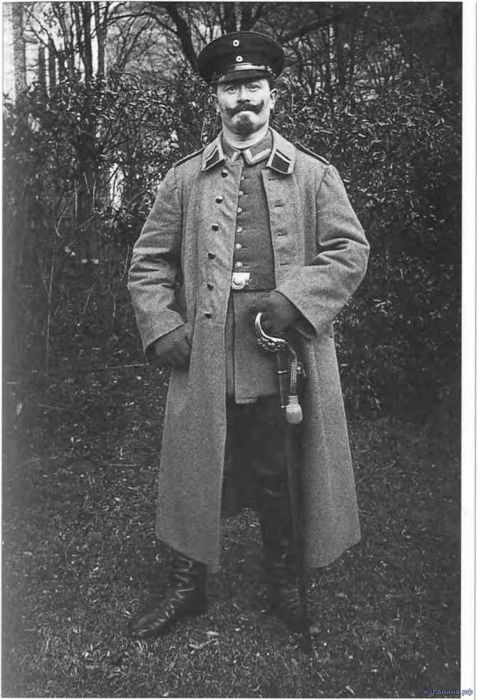 Prussian Vizefeidwebel Maxiner, pictured at Bad Ems, February 1915. Maxiner wears the Dienstmutze; light grey greatcoat over field grey uniform and belt, boots and gloves. Note that the Vizefeidwebel is a portepee rank, so that a sword and knot are carried in addition to the distinctive bars of lace on the jacket and greatcoat collars. Experiments with feldgi'au or ‘field grey’ uniforms with a view to producing a costume good from the point of view of concealment, yet smart and practical under the conditions of modern war, had begun in the German army as early as 1907. This departure was late by the standards of the British who had adopted a universal khaki service dress in 1902, or the Russians who took up a greenish khaki in 1907, yet it was well ahead of the Belgians and of the French who in 1914 had not yet abandoned their blue uniforms and famous red trousers. Moreover the use of grey and green uniforms in Germany and Prussia was not without precedent. Prussian reservists had worn grey in die Napoleonic wars, and certain units in undress, and others in full dress, most notably Jdgei' and Jiigerzu Pferde, had been wearing greens and greys well before 1907. It appears that by 1908 as a part of the first widespread practical tests some units were issued with field grey uniforms of a smooth heavy woollen cloth with an off-white cotton lining. The lace and buttons with which these first field grey uniforms were decorated seem to have been identical with those in use on the contemporary Diinkclblau uniforms. The experiment must have been accounted a success for in the spring of 1910 the Kaiser signed orders for the general introduction of field grey, and soon after the active regiments were sporting a light field grey. It was not possible to re-equip all the reserve, Landwebr and Landstnrm formations overnight, and photographic evidence suggests that many of these bodies continued to use dark blue uniforms out of the front line as late as 1916. Officially, coloured dress uniforms were abandoned in 1915 at the same time as the introduction of a new field grey full dress for use after the war. Interestingly there is some evidence to suggest that a small minority of units actually campaigned in blue in 1914 before they could be reclothed. 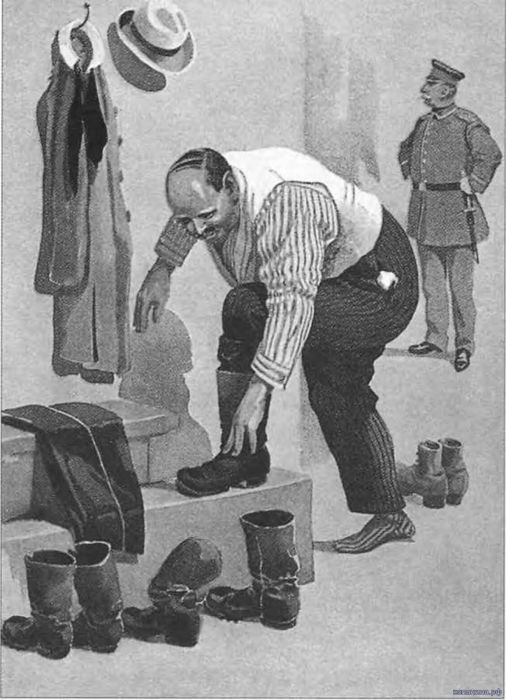 A philosophical view of the conscript’s journey into uniform:‘he who has choice has pain’. The popular picture of a monolithic German army, universally clad in identical Model 1910 uniform at the outbreak of war is undoubtedly wrong, partly because of the many state variations and because many types of troops carried over distinctions from the full dress of their particular arm of sendee. In this respect the German uniform of 1914 was more truly a ‘sendee’ version of the existing uniform than the British Sendee Dress, which bore little relationship to its full dress equivalent. Thus it was that the most common of the 1910- type jackets was a field sendee version of the Waffenrock, also referred to as a Feldrock. This was field grey for the majority of the infantry and cavalry and grev-green, grang/iin, for the Jdger, mounted and dismounted, and for the machine-gun detachments. The basic garment was a fairly loose fitting coat closed by eight nickel or tombak (zinc-copper alloy) buttons in front and in the skirts were pockets which were fastened with buttoned flaps. The collar was of a stand and fall variety7. Issue jackets were usually stamped internally with the letters ‘B.A.’ signifying Bekleidnngsamt or ‘clothing department’, followed by Roman numerals denoting the Army Corps and a date. Unit marks are also encountered where a number followed by ‘J.R.’ or ‘I.R.’ shows a specific infantry regiment, and the prefix ‘B’ before such a number signifies Bavarian. Scarlet piping to the Waffenrock denoted the infantry and machine-gunners, green piping the Jager, and green piping to the body of the jacket with black collar and cuff piping the Scbiitzen and 2nd Guard machine-gun detachment. Artillery7 and pioneers had red piping to the body of the jacket with black collar and cuff piping; medical troops had dark blue piping. Officers’ uniforms were not usually issue garments, being paid for by the officer concerned and made to order. As might be expected the result was a uniform ol better quality and fit. Rank insignia were carried on the shoulder, along with any regimental device. Staff officers wore red collar patches. General officers were distinguished by a special pattern of sendee dress jacket, this had red piped turn back or ‘roll’ cuffs, and integral breast pockets with flaps. This jacket also had distinctive long, red collar patches on which appeared a special embroidery which differed according to state. Other minor variations are apparent in photographs. On formal occasions the General officers’ jacket was worn with distinctive field grey trousers which had triple red stripes down the legs. The outbreak of war saw the recall of many senior officers who had not been active in the past four years, and so it was that a number of older Generals began the war in obsolete uniform. Hindenburg himself set off for the Eastern Front wearing the Liteu'ka of die 3rd Guards regiment.The jackets worn by the Kiirassiere, Dragoner, and Jdger zn Pferde were similar to the Waffenrock of the infantry but had a stand up collar and used regimentally coloured pipings. The collars and cuffs of these garments (except those of the Dragons) were also trimmed with Boitenbesatz or regimentally patterned braid. Hussar units wore a field grey Attila rather than the Waffenrock, complete with five looped bars of dull grey braid on the chest, and shoulder cords rather than straps, whilst Ulanen, or lancers, wore a field grey Шапка. This garment was a double-breasted tunic with two rows of seven buttons, pointed cuffs, and a stand up collar. Chaplains were exceptional in that they tended to wear a long frock coat. Thus far the picture was reasonably straightforward, but it was further complicated by differences to buttons, cuffs, skirt ornaments, Litzen, and shoulder straps. Jacket buttons were of two main types; embossed with a lion for Bavarian units and otherwise usually bearing the state crown of the units’ origin. A small version of the button was used to fasten the shoulder straps. The majority of regiments started the war with tombak buttons; tombak being an alloy of 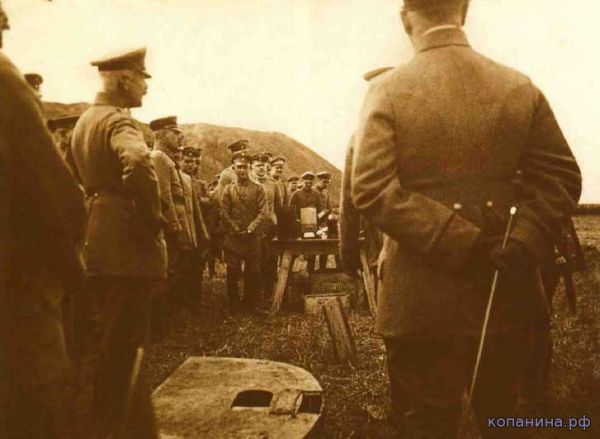 An unauthorised private photograph showing General Hermann von Francois, commander of 1 Corps during an Eastern Front briefing. Frarujois gained a reputation as a difficult and aggressive commander, but was arguably one of the driving forces behind the victory at Tannenberg which made Hindenburg’s reputation. zinc and copper which had a reddish brass appearance. Certain units, mainly of the Guard, wore nickel buttons. Fairly quickly, however, such distinction was eroded by the fact that many new jackets were produced with dull grey, painted buttons and that other alloys or war-time substitute materials, generically known as Kriegsmettall, came into use. The main four cuff patterns of the Waffenrock were the Brandenburg, Swedish, Saxon (sometimes referred to as German), and French. The Brandenburg was the commonest, having an oblong vertical flap with three buttons. The Saxon which had two buttons arranged one below and one above the piping was used by Saxon units excepting the Saxon Grenadier regiments 100 and 101. The Swedish cuff had two buttons arranged horizontally below the piping and was worn amongst others by senior officers, machine-gun units, many of the Guards, Baden Leib Grenadier regiment 109, Wiirttemberg Grenadier regiments 119 and 123, the aforementioned Saxon Grenadier units and the field artillery, Kiirassiere and dragoons. T he French cuff which had three vertical buttons mounted with Litzen was worn by the Garde Scbiitzen, and the by the 2nd Guard machine gun detachment. The usual rear skirt ornamentation on the original 1910-type Waffenrock had four buttons, two down either side, whilst the Saxon arrangement had only two buttons and a different pattern of piping. Collar and cuff Litzen, or small decorative bars of material of a contrasting colour, were traditionally associated with the Guards and other senior regiments of the army. Collar Litzen were worn on the collar and extended as far as a point level with the shoulder strap button; cuff Litzen were placed one on each button, three horizontally on a Brandenburg cuff, two vertically on a Swedish cuff. The three main patterns were ‘double’, ‘single’ and ‘Old Prussian’ which came to a point at one end. Usually Litzen were white with a red centre line, the main exceptions being Fusilier regiment 80, which had no centre line; the Guard and 14th Jiiger battalions which had green; and the Garde Scbiitzen and 2nd machine-gun detachment which had black. Guard machine-gunners were also unusual in that the area between their double yellow Litzen was infilled red or black, depending on whether they wereof the 1st or 2nd detachment. The 5th Guard Grenadiers, the Garde Jiiger and Scbiitzen, had yellow Litzen. Old Prussian Litzen were worn by the 5th Guards, both the zn Fuji and Grenadier regiments, as well as the Fusilier regiment Nr. 90. Single Litzen were worn by line Grenadier regiments. Guard regiments 1-4 inclusive, both of the zu Fuji, and Grenadiers wore double Litzen, as did the Guard Fusiliers, Grenadier regiments 89,100,101,109, 115, 119 and 123 and the Guard Jiiger, Scbiitzen and machine-gun detachments. Both unit designations and Army Corps could be revealed by the button down shoulder strap of the original 1910 Waffenrock and during the war the taking of German shoulder straps from prisoners or captured clothing provided enemy intelligence with a vital source of information. The shoulder strap piping of Guard regiments was an indicator of seniority; 1stregiments having white; 2nd regiments red; 3rd regiments yellow; 4th regiments light blue and the Guard Fusiliers wore lemon yellow shoulder strap piping. Jiiger battalions wore green shoulder strap piping on the Waffenrock and Guard Scbiitzen red. Air Serv ice, Telegraph and Communications troops had light grey piping. In the infantry this peripheral stripe of colour indicated the Army Corps; 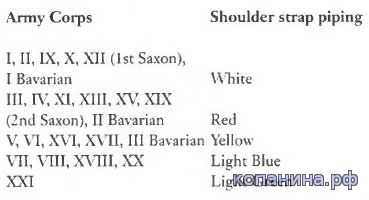 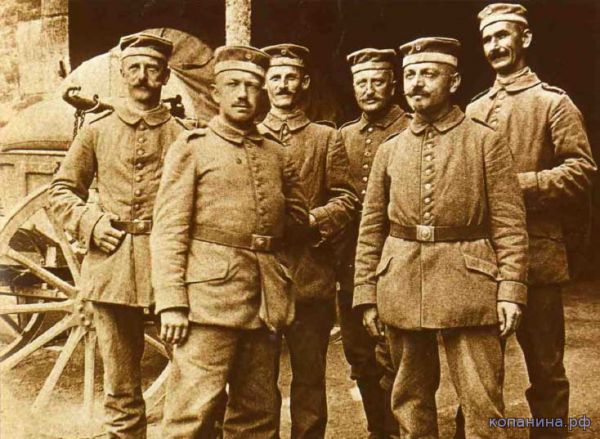 Saxon infantrymen on the Western Front. The features which distinguish their uniform from that of other states are: the form of the cuff on the Waffenrock; the Saxon white, green, white, lower cap cockade which here is covered by a grey camouflage band; the Saxon belt buckle; and the form of the rear skirts of the jacket. | |
| Просмотров: 2446 | | |
| Всего комментариев: 0 | |